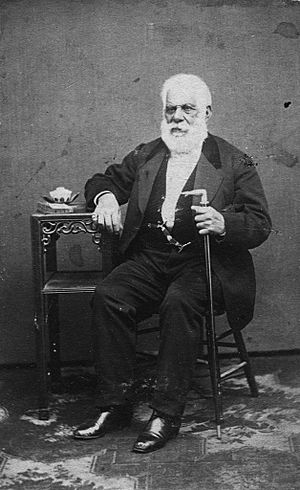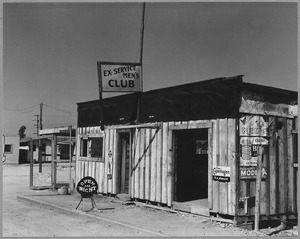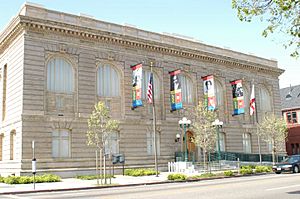African Americans in California facts for kids
 |
|
| Regions with significant populations | |
|---|---|
| Fillmore District and Bayview-Hunters Point in San Francisco; Oakland and the East Bay Area; Vallejo, Berkeley, Fairfield and Hayward in the San Francisco Bay Area; Compton, South Los Angeles, Gardena, Carson, Palmdale, Lancaster, Long Beach and Inglewood; Southeast San Diego; San Bernardino and Moreno Valley, Victorville, Rialto and other Inland Empire cities;, Stockton, Elk Grove and Sacramento; North Bakersfield and North Fresno | |
| Languages | |
| California English, African-American Vernacular English; African languages spoken by African immigrants, Caribbean languages spoken by the black Caribbean minority, and Spanish spoken by Black Hispanics | |
| Religion | |
| Christianity, Irreligion | |
| Related ethnic groups | |
| Non-Hispanic or Latino African Americans, African immigrants in the United States, West Indian Americans, Black Hispanic and Latino Americans |
African American Californians, also known as Black Californians, are people living in California who have African roots. In 2019, about 5.8% of California's population, or 2.2 million people, identified as African American or Black. If you include those with some African heritage, the number goes up to 7.0%, which is about 2.8 million residents.
Many Black communities live in counties like Alameda, Contra Costa, San Francisco, and Solano in the San Francisco Bay Area. You can also find large populations in Sacramento County and San Joaquin County. In Southern California, many Black residents live in Los Angeles County, San Bernardino County, and San Diego County.
California is also home to a growing number of people from the Afro-Caribbean and African immigrant communities. Many African immigrants in California come from countries like Ethiopia and Eritrea. A special area called Little Ethiopia in West Los Angeles is home to many Ethiopians. California has one of the largest groups of Black African immigrants in the United States. There is also a mixed heritage community called Blaxican (Black and Mexican) in California, especially in Los Angeles.
African Americans have greatly influenced California's music, culture, and hip hop scene. Famous musicians like Tyga, Saweetie, Doja Cat, Jhené Aiko, Tyler, the Creator, Frank Ocean, Dr. Dre, and Snoop Dogg are of African American descent and have strong ties to California.
California has the largest number of multiracial African Americans in the United States.
The very first Black residents in California were Afro-Latino enslaved people brought by the Spanish.
Over time, the Black population in some parts of California has changed. Some African Americans have moved to more affordable areas within California, like the Inland Empire or Central Valley. For example, many people moved from Los Angeles to desert areas like Palmdale and Lancaster in the 1990s. The Black population has also decreased in cities like San Francisco.
Many African Americans moved to California from Southern states like Oklahoma, Louisiana, Arkansas, and Texas during the Second Great Migration. This was a time when many Black families moved from the South to other parts of the U.S. for better opportunities.
People who identify as Black in California have diverse backgrounds. Their heritage can include African American, Mexican, Spanish, Jamaican, Nigerian, Ethiopian, Haitian, and many other cultures from around the world.
Most Africans in California come from countries like Ethiopia, Nigeria, Somali, Kenyan, Ghana, Liberian, Sierra Leonean, Sudanese, Ugandan, Cape Verdean, Zimbabwean, and South Africa. There are also many people from Jamaica, Haiti, and other Caribbean islands, as well as Afro-Latino and Afro-Belizean communities.
In some neighborhoods and cities in California, the Black population has changed. Areas like Compton, Inglewood, and Watts, which were once mostly Black, now have more Latino residents.
Contents
A Look at History
Racial/Ethnic Makeup of California (2017) White Non-Hispanic (36.97%) Black Non-Hispanic (5.47%) Native American Non-Hispanic (0.37%) Asian Non-Hispanic (14.37%) Pacific Islander Non-Hispanic (0.35%) Other Non-Hispanic (0.27%) Two or more races Non-Hispanic (3.05%) Hispanic Any Race (39.15%)

People of African descent first came to California from Mexico during the Spanish Conquest. The Spanish brought enslaved Africans to California. Many people of mixed African and European heritage lived in Alta California. Spanish soldiers, priests, and settlers brought both enslaved and free Black people to the state in the 1700s.
African Americans arrived in California by 1860, looking for gold during the California Gold Rush. Some white slave owners brought their enslaved Black people to work in the California mines in 1849. These owners and enslaved people mostly came from Texas, Mississippi, Missouri, and Arkansas.
The first official count of African Americans in California was in 1850, showing 962 people. By 1860, this number grew to 4,086. By 1910, it reached 22,000.
Between 1940 and 1970, many African Americans moved to California from the Southern United States. They were escaping unfair Jim Crow rules and looking for better job opportunities. Before the Second World War, African Americans made up less than one percent of California's population. After the war, their population grew a lot. Many came from Arkansas, Louisiana, Oklahoma, and Texas to work in factories that supported the war effort. Some Black Louisianans who moved to California were Louisiana Creoles.
In recent years (the 2010s), California saw more Black people move out of the state than into it for the first time in 30 years. Many who left California returned to the South, especially to Texas and the Atlanta metropolitan area.
Today, there are Black neighborhoods and cities with more than 15% Black populations in Southern California, like Compton, South Los Angeles, and Inglewood. In Northern California, these areas include Stockton, Oakland, and Vallejo.
Oakland is well-known as a center for Northern California's Black population, with at least 25% of its residents being Black in 2020. Many African Americans who settled in Oakland and the East Bay areas in the early to mid-1900s worked on the railroad.
Media and Information
African American residents of California were first written about in 1919 by Black Californian historian Delilah Beasley. Later, others like Rudolph Lapp also shared information. You can find more details in journals like The Journal of Negro history and The Journal of African American History. Other California publications about African Americans include the California Eagle, California Voice, and Los Angeles Sentinel.
Education and Learning
In 1872, African Americans sent a request to the Los Angeles Board of Education. Because of this, the California Supreme Court decided that separating students in schools was against the U.S. Constitution's 14th and 15th amendments. This ruling helped end school segregation.
The number of African American students in lower education grew from 24 in 1870 to 183 by the late 1800s. By 1900, these students were among the top performers in reading and writing. In 1994, African American students made up about seven percent of those in higher education in California.
Health Matters
Sadly, Black Californians have higher rates of death from certain health issues. They have the highest death rates from breast, cervical, colorectal, lung, and prostate cancer. Black people in California are also dying at a higher rate from COVID-19 compared to other groups in California.
Politics and Government
African Americans in California are very active in politics. In a 2020 exit poll, 82% of African Americans in California voted for Joe Biden. Most African American voters, 82%, are registered as Democrats. In 2016, 88% of African Americans in California voted for Hillary Clinton.
Kamala Harris is a very important figure. She is the first African American female Vice President of the United States. She was born and grew up in California.
Ancestry and Demographics
| Ancestry by origin | Number |
|---|---|
| 1462 | |
| 33,538 | |
| 4854 | |
| 3228 | |
| 2415 | |
| 36415 | |
| 0 | |
| 1278 | |
| 5022 | |
| 3376 | |
| 3538 | |
| 1710 | |
| 408 | |
| African | 110116 |
| Other subsaharan African | 10287 |
Notable Black Californians

- Miguel
- Tyra Banks
- Reggie Bush
- Snoop Dogg
- Tyga
- YG
- Frank Ocean
- Tiger Woods
- Kamala Harris
- Paul George
- H.E.R.
- Zoë Kravitz
- Saweetie
- Danny Glover
- Anthony Anderson
- RuPaul
- Karrueche Tran
- Kendrick Lamar
- Kofi Siriboe
- Lauren London
- Rashida Jones
- Dwayne Johnson
- Nick Cannon
- Shane Mosley
- Issa Rae
- Lakeith Stanfield
- Barry Bonds
- Etta James
- Zendaya
- Tyrese Gibson
- Doja Cat
- Blueface
- James Harden
- Russell Westbrook
- Nick Young
- Jhené Aiko
- Tyler, The Creator
- Tinashe
- Dr. Dre
See also
- Second Great Migration (African American)
- African Americans in San Francisco
- History of the African Americans in Los Angeles
- California locations by race
- Demographics of California
- Afro-Mexicans
- Hispanics and Latinos in California
- Blaxican
- Black Southerners
- African Americans in Texas
- African Americans in Georgia
- African Americans in Oklahoma
- African Americans in Louisiana
- Indigenous peoples of California
- White Americans in California
- Little Ethiopia
- Asian Americans in California
- African Americans in Oregon
- List of African-American newspapers in California
- History of California
- New Great Migration
- Romani people in California
- Mexicans in California










